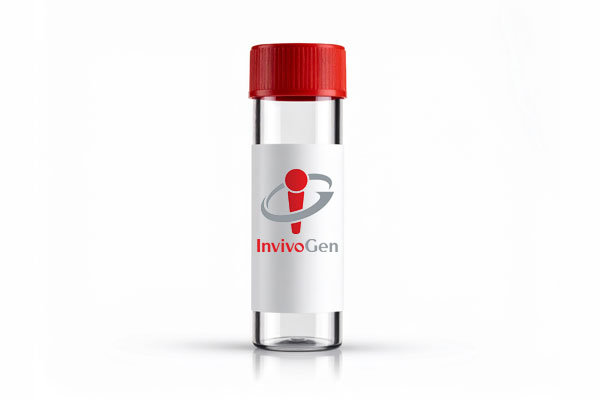The innate immune system reacts to diverse molecules of microbial origin, termed pathogen-associated molecular patterns (PAMPs), or released from damaged or dying cells, called damage-associated molecular patterns (DAMPs).
These molecules include nucleic acids, such as DNA. While the recognition of extra-cellular DNA involves mainly Toll-like receptor 9, recognition of cytosolic DNA appears to involve several sensors.
DAI
The first identified cytosolic DNA sensor, named DNA-dependent activator of IFN-regulatory factors (DAI), binds cytosolic dsDNA and leads to the production of type I IFNs [1]. However, DAI deficiency does not affect the induction of type I IFNs in response to poly(dA:dT), a synthetic analog of B-DNA, suggesting that redundant cytosolic DNA sensors exist [2].
RIG-I
Unexpectedly, the next candidate receptor was the RNA helicase retinoic acid-inducible gene-I (RIG-I), an RNA-binding and not DNA-binding protein. A human cell line deficient for RIG-I was shown to lack the ability to recognize poly(dA:dT) [3].
Recently, two independent teams confirmed the involvement of RIG-I in the response to dsDNA and demonstrated that rather than the cytosolic DNA, an RNA intermediate was responsible for RIG-I activation. They found that transfected poly(dA:dT) is transcribed by RNA polymerase III in the cytoplasm and potentially in the nucleus into a double-stranded RNA intermediate. This dsRNA molecule contains a 5’-triphosphate moiety and is recognized by RIG-I [4, 5].
Both DAI and RIG-I induce the production of type I IFNs through the TBK1/IRF3 pathway.
The endoplasmic reticulum (ER)-resident transmembrane protein stimulator of IFN genes (STING) is a key component of this pathway [6]. STING seems to function as an adaptor protein upstream of TBK1.
LRRFIP1
Recently, a third IFN-inducer cytosolic dsDNA sensor has been identified [7]. This sensor LRRFIP1 can recognize AT-rich B-form dsDNA as well as GC-rich Z-form dsDNA.
With the use of LRRFIP1-specific siRNA, Yang et al. demonstrated that LRRFIP1 triggers the production of IFN-β in a β-catenin-dependent manner. β-Catenin binds to the C-terminal domain of IRF3 inducing an increase in IFN-β expression.
AIM2
Although the production of type I IFNs is the main pathway induced by cytosolic dsDNA, production of the pro-inflammatory cytokines IL-1β and IL-18 has also been observed. Recently, several groups have identify AIM2 (absent in melanoma 2), a member of the hematopoietic interferon-inducible nuclear protein HIN-200 family, as a cytosolic dsDNA sensor which activation promotes the assembly of an inflammasome [8-10]. DNA of various origins, such as poly(dA:dT), plasmidic DNA and DNA from the bacterium L. monocytogenes have been shown to activate AIM2 [11]. Upon activation, AIM2 interacts with ASC, a common adapter of the inflammasomes, leading to the cleavage of caspase-1 and the secretion of IL-1β and IL-18.
p202 is another member of the HIN200 family shown to bind cytoplasmic dsDNA but, in contrast to AIM2, it represses caspase activation [12].
The recognition of cytosolic DNA is more complicated than first anticipated. Several sensors have been identified that trigger different signaling pathways in a cell type-specific manner. Still, the general consensus is that another unknown cytosolic DNA-recognition system , independent of the TLRs and RIG-I, may exist. Further studies to elucidate the complex mechanisms of cytosolic DNA recognition may help the development of new strategies to treat inflammatory diseases.
References
1. Takaoka A. et al., 2007. DAI (DLM-1/ZBP1) is a cytosolic DNA sensor and an activator of innate immune response. Nature. 448(7152):501-5.
2. Ishii KJ. et al., 2008. TANK-binding kinase-1 delineates innate and adaptive immune responses to DNA vaccines. Nature. 451(7179):725-9.
3. Cheng G. et al., 2007. Double-stranded DNA and double-stranded RNA induce a common antiviral signaling pathway in human cells. Proc Natl Acad Sci U S A. ;104(21):9035-40.
4. Ablasser A. et al., 2009. RIG-Idependent sensing of poly(dA:dT) through the induction of an RNA polymerase III-transcribed RNA intermediate. Nat Immunol. 10(10):1065-72.
5. Chiu YH. et al., 2009. RNA polymerase III detects cytosolic DNA and induces type I interferons through the RIG-I pathway. Cell. 138(3):576-91.
6. Ishikawa H. & Barber GN., 2008. STING is an endoplasmic reticulum adaptor that facilitates innate immune signalling. Nature. 455(7213):674-8.
7. Yang P. et al., 2010. The cytosolic nucleic acid sensor LRRFIP1 mediates the production of type I interferon via a beta-catenindependent pathway. Nat Immunol. 11(6):487-94.
8. Hornung v. et al., 2009. AIM2 recognizes cytosolic dsDNA and forms a caspase-1-activating inflammasome with ASC. Nature. 458(7237):514-8.
9. Fernandes-Alnemri T. et al., 2009. AIM2 activates the inflammasome and cell death in response to cytoplasmic DNA. Nature. 458(7237):509-13.
10. Bürckstümmer T. et al., 2009. An orthogonal proteomic-genomic screen identifies AIM2 as a cytoplasmic DNA sensor for the inflammasome. Nat Immunol. 10(3):266-72.
11. Jones Jw. et al., 2010.Absent in melanoma 2 is required for innate immune recognition of Francisella tularensis. PNAS, 107(21):9771-6.
12. Roberts TL. et al., 2009. HIN-200 proteins regulate caspase activation in response to foreign cytoplasmic DNA. Science ;323(5917):1057-60.


